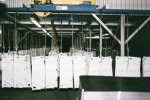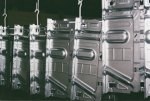Breaking Through The Faraday Cage
Because of its formulation and chemistry, this high-yield polyester powder can get inside any Faraday cage...
If you have ever powder coated parts with inside corners or complex geometries, it is likely that you have experienced the Faraday cage effect. For those of you who have not, the Faraday cage is like an invisible electrical screen that prevents charged powder particles from reaching internal corners and recesses. If the powder particles cannot reach these areas, then the part will not be completely coated, which will probably result in premature corrosion.
Breaking the cage
The Faraday cage effect can be overcome in a number of ways. Reducing the output of the spray gun will increase the size of the holes in the cage, allowing more powder particles to pass through. But, reducing the output of the spray gun will probably require the powder coater to decrease line speed to ensure complete coverage. Another solution is for the gun operator to change spraying angles. Instead of spraying directly into an inside corner or recess, the operator can spray at a more oblique angle. Sometimes this is not possible because of the racking configuration and the type of spray guns used (two-axis automated guns).
However, Stiglitz Corp., Louisville, KY, has found another alternative: Corvel® HY high-yield polyester powder coatings from Morton International, Inc. According to Terry Gill, vice president at Stiglitz, "We felt that Morton had the expertise, know-how and knowledge to solve our problem. Stiglitz has always demanded a hands-on approach from all of its suppliers, and Morton understands that. Its approach was to get in there and get it done."
Problem parts
Stiglitz, the second oldest business in the state of Kentucky, is a job shop that performs stamping, fabricating, powder coating and assembly of cold-rolled steel, mainly for the appliance and the automotive industry. Anywhere from 50 to 60% of the company's business comes from General Electric.
For several years the company had difficulty powder coating two parts because of the Faraday cage effect. The first part had a U-shaped channel that traveled the entire length of the part. The channel was approximately one to 1.5 inches wide. Because of the narrow width of the channel and its depth, a strong Faraday cage would develop whenever Stiglitz tried to powder coat the part. In order to force the powder into this area, Stiglitz had to increase the spray gun's velocity and preheat the part. "With a preheated part, the powder will melt rapidly, adhering to the part rather than being blown away by the spray gun air from repeated applications," stated Rick Alvey, sales representative from the powder supplier. But, the time required to preheat the part forced the company to reduce its line speed from 10 to seven fpm.
The second part that Stiglitz had difficulty powder coating was a refrigerator drain pan. The drain pan was fairly flat except for a bump right next to the edge of the pan (see photos). Between the bump and the edge of the pan was a strong Faraday cage. The customer required that this part be white, but white is a difficult color to get into Faraday cage areas. Because of the white powder coating, any area that was not covered was easily seen in the inspection area.
Benefits of the change
Due to the chemistry and formulation of the high-yield polyester powder, Stiglitz has observed three advantages: enhanced penetration into recesses; increased first pass transfer efficiency; and an accelerated cure cycle.
Enhanced penetration into recesses is exactly what Stiglitz needed to solve the problems it was having in coating the two parts previously mentioned. Because of the ability of the powder to break through the Faraday cage, both of these parts now receive complete coverage at the required film build. This does not mean that flat areas or edges near the Faraday cage are coated with too much powder, which is a common occurrence when solving Faraday cage problems. In addition to achieving coverage in all recesses, the powder has also provided a more uniform film thickness over the entire part.
Stiglitz has also benefited from the powder's increased first pass transfer efficiency. The increase in first pass transfer efficiency is related to the high-yield powder's ability to reach recesses and its excellent application characteristics. Because the powder provides good penetration, more powder actually reaches the part instead of being deflected by the Faraday cage. The increase in first pass transfer efficiency means that there is less powder for Stiglitz to reclaim. It also means that there is less need for touch-up by the company's manual operators.
The final benefit is the accelerated cure cycle. An accelerated cure cycle means that more parts can move through the oven in a shorter period of time. This results in a lower energy use per part.
When added together, these benefits have resulted in increased productivity. Instead of choosing another alternative that might have decreased productivity, the high-yield polyester powders have actually allowed Stiglitz to increase its productivity. Remember that Stiglitz originally ran its line at 10 fpm, but had to reduce that to seven fpm to overcome the Faraday cage problems. However, with the new powder, it has been able to increase its line speed above the original 10 fpm to 13 fpm.
To learn more visit AkzoNobel Powder Coatings.
Related Content
Curing Oven Basics
Simply heating up the substrate does not cure the coating. There are many variables to consider when choosing the best cure oven for your application...
Read MoreProducts Finishing Reveals 2024 Qualifying Top Shops
PF reveals the qualifying shops in its annual Top Shops Benchmarking Survey — a program designed to offer shops insights into their overall performance in the industry.
Read MoreAn Altruistic Growth Strategy Puts People First
Professional Plating emphasizes investing in its team and fostering a supportive environment on the shop floor.
Read More12 Ways to Improve Your Powder Coating Quality
Often overlooked powder coating procedures that can help you elevate your quality, streamline your operations and improve your profitability.
Read MoreRead Next
Delivering Increased Benefits to Greenhouse Films
Baystar's Borstar technology is helping customers deliver better, more reliable production methods to greenhouse agriculture.
Read MoreEducation Bringing Cleaning to Machining
Debuting new speakers and cleaning technology content during this half-day workshop co-located with IMTS 2024.
Read MoreA ‘Clean’ Agenda Offers Unique Presentations in Chicago
The 2024 Parts Cleaning Conference, co-located with the International Manufacturing Technology Show, includes presentations by several speakers who are new to the conference and topics that have not been covered in past editions of this event.
Read More
.JPG;width=70;height=70;mode=crop)
























